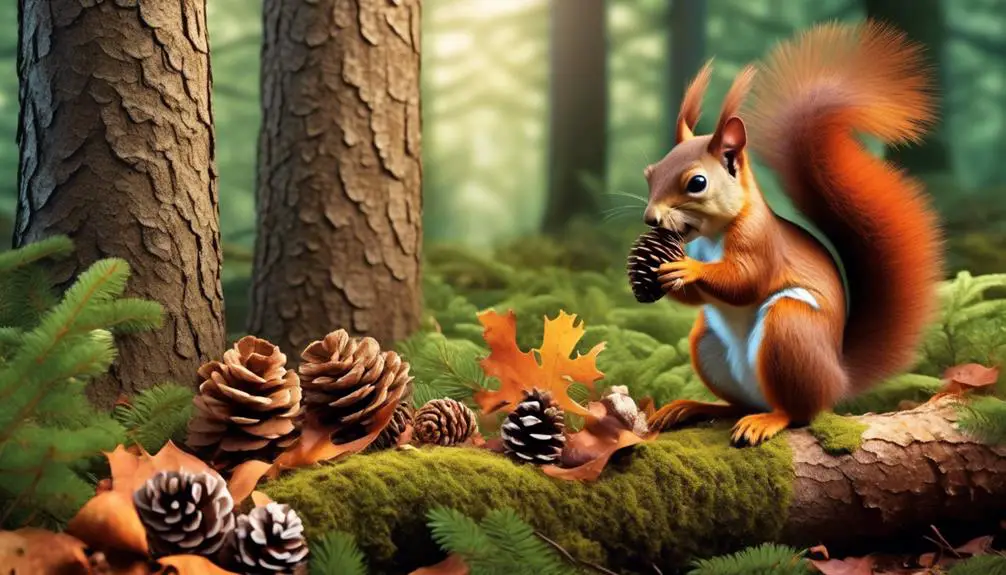Are you curious about the unconventional eating habits of animals? Well, prepare to be amazed because you won’t believe what some creatures devour.
Pine cones, those prickly and seemingly inedible structures, actually serve as a feast for various wildlife. From the nimble squirrels that meticulously collect and store pine cones to the resourceful raccoons that have no qualms about chowing down on them, these fascinating creatures have developed unique ways to access the nutritious seeds inside.
But that’s not all; deer, woodpeckers, and chipmunks also have their own tricks up their sleeves when it comes to munching on pine cones.
So, if you’re ready to explore the intriguing world of these pine cone-eating animals and uncover their remarkable adaptations, get ready for an eye-opening journey into the wilderness.
Squirrels and Pine Cones
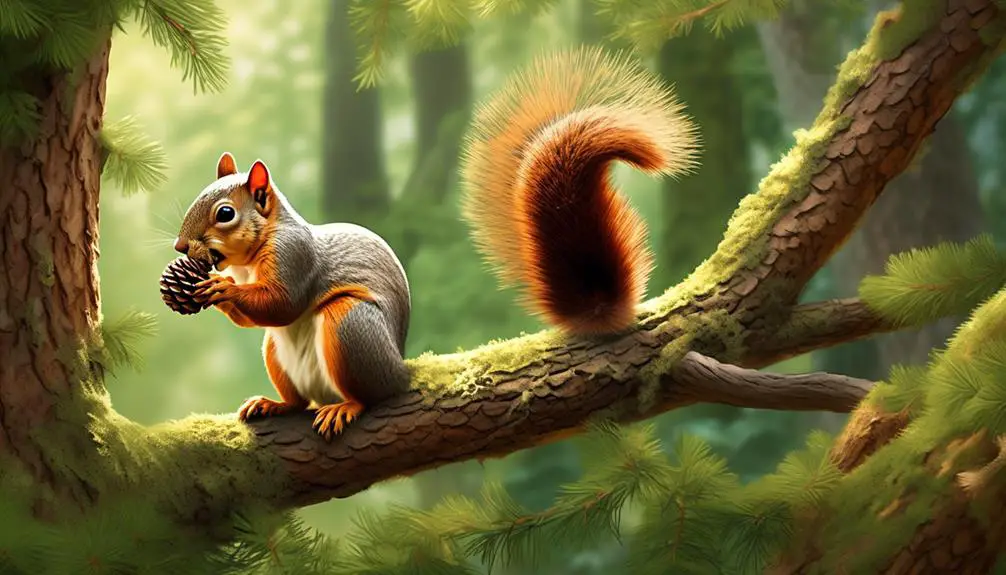
Squirrels, small and agile rodents, play a crucial role in the dispersal of pine cones by collecting and storing them for future consumption. These industrious creatures have a remarkable ability to locate and gather pine cones from the forest floor.
With their sharp teeth, squirrels chew on the scales of brown pine cones to access the nutritious seeds hidden inside. They can also break open dry pine cones from bottom to top, revealing the delectable rewards within. Not only do squirrels feast on the seeds themselves, but they also collect and store female pine cones for later consumption.
Even green pine cones are no match for their determined jaws, as squirrels skillfully extract the seeds from these unripe cones. As they gather and hoard pine cones, squirrels inadvertently contribute to the dispersal of these cones and the subsequent growth of new pine trees.
Their diligent efforts ensure the survival and propagation of pine forests, making them an integral part of the ecosystem.
Deer and Pine Cones
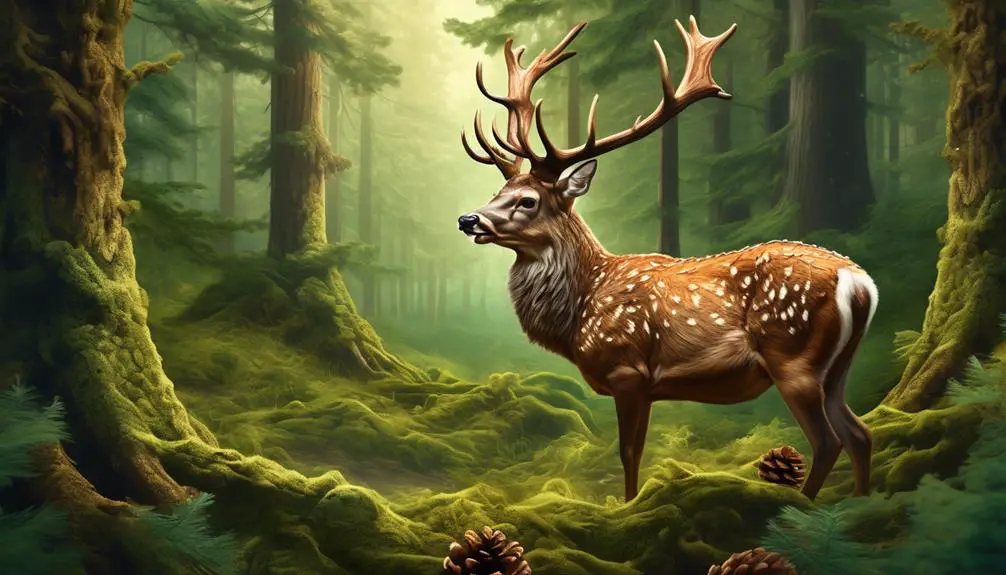
Deer rely on pine cones for nutrition during winter when other food sources are scarce.
Pine cones provide a valuable source of sustenance for deer, as they contain seeds that are rich in nutrients.
The nutritional benefits of pine cones play a crucial role in the winter survival of deer, attracting them towards these cone-bearing trees for their much-needed nourishment.
Nutritional Benefits of Pine Cones
Pine cones offer valuable nutritional benefits for certain animals, particularly during the winter months when other food sources may be scarce. Deer, in particular, rely on pine cones as a source of nutrition when suitable foliage is lacking. Pine cones, along with pine needles, serve as a vital food source for deer during this time.
The whitetail deer, in particular, is known to feed on pine cones. These cones are available from mid-September to mid-December and provide sustenance for deer throughout the winter. The high fiber content and rich nutrients found in pine cones make them a valuable source of energy for deer, helping them survive the harsh winter conditions when other food options are limited.
Role of Pine Cones in Winter Survival
During the winter months, certain animals rely on the nutritional benefits of pine cones as a vital source of energy when suitable foliage is scarce. Deer, in particular, consume pine cones and pine needles during this time.
The lack of suitable foliage during winter draws deer towards pine cones, which fall from mid-September to mid-December, providing them with much-needed sustenance. The whitetail deer, known for its adaptability, is known to feed on pine cones. These cones serve as an important food source for deer, helping them survive when other food sources are limited.
Therefore, the role of pine cones in winter survival for deer can’t be understated. They provide a valuable source of nutrition, helping these majestic creatures endure the harsh winter conditions.
Woodpeckers and Pine Cones
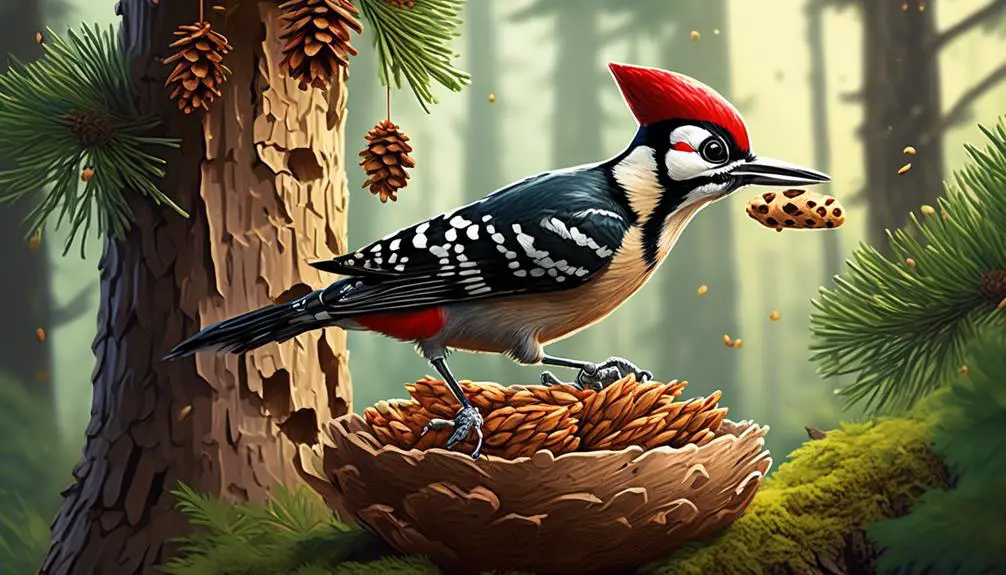
Woodpeckers, with their sharp beaks, efficiently break open pine cones to access the nutritious seeds inside. These birds have adapted specialized tools for this task. Their strong, chisel-like beaks allow them to easily penetrate the tough outer scales of the pine cones. Woodpeckers often jam the pine cones into branches or crevices before pecking into them, providing a better grip and stability during the feeding process. The broken pine cones at the base of pine trees are clear evidence of woodpecker activity.
Pine cone seeds are an important part of a woodpecker’s diet. They provide a rich source of energy and nutrients. As the woodpecker breaks open the pine cone, it exposes the seeds hidden within. These seeds are small and have a high fat content, making them an ideal food source for these birds. Woodpeckers play a crucial role in the dispersal of pine cone seeds, as they often drop or lose some seeds while feeding.
Woodpeckers are known for their ability to extract food from various sources, including tree bark and dead wood. However, pine cones offer them a unique opportunity to access a concentrated supply of seeds. This behavior demonstrates the adaptability and resourcefulness of woodpeckers in finding and utilizing food sources in their environment.
Raccoons and Pine Cones
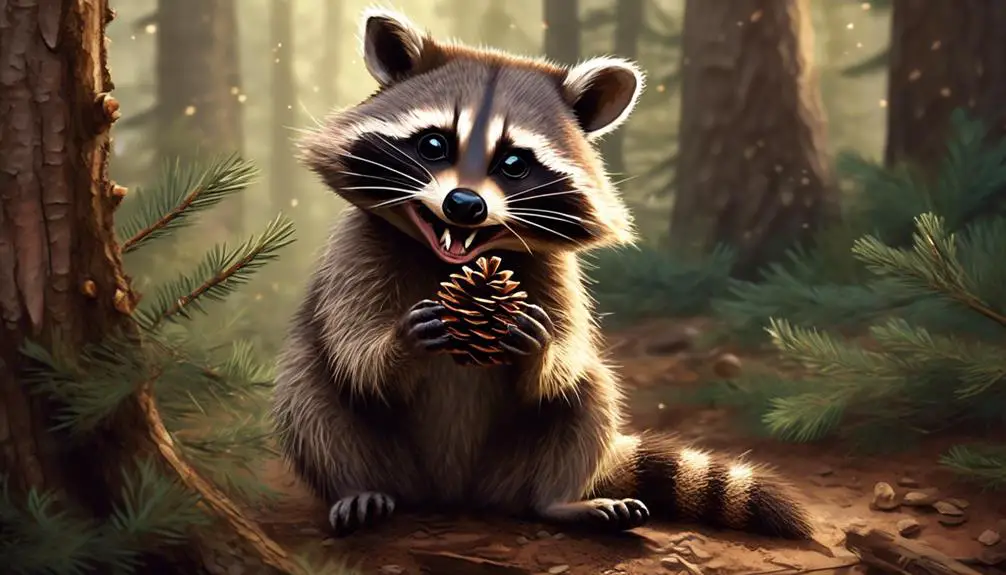
Raccoons, like woodpeckers, have developed unique strategies to access the nutritious seeds hidden within pine cones. These clever creatures, known for their scavenging nature, have adapted to climb coniferous trees in search of food, including pine cones.
With their sharp claws, raccoons skillfully break open the outer case of pine cones, revealing the tasty seeds inside. They’re able to manipulate the cone with precision, using their dexterous paws to hold it steady while extracting the seeds.
Their omnivorous diet makes pine cones a suitable food source for raccoons, as they’re always on the lookout for sustenance in various environments, including urban areas. Raccoons are known for their resourcefulness, and their ability to access the nutritious seeds within pine cones is just another example of their adaptability.
Chipmunks and Pine Cones
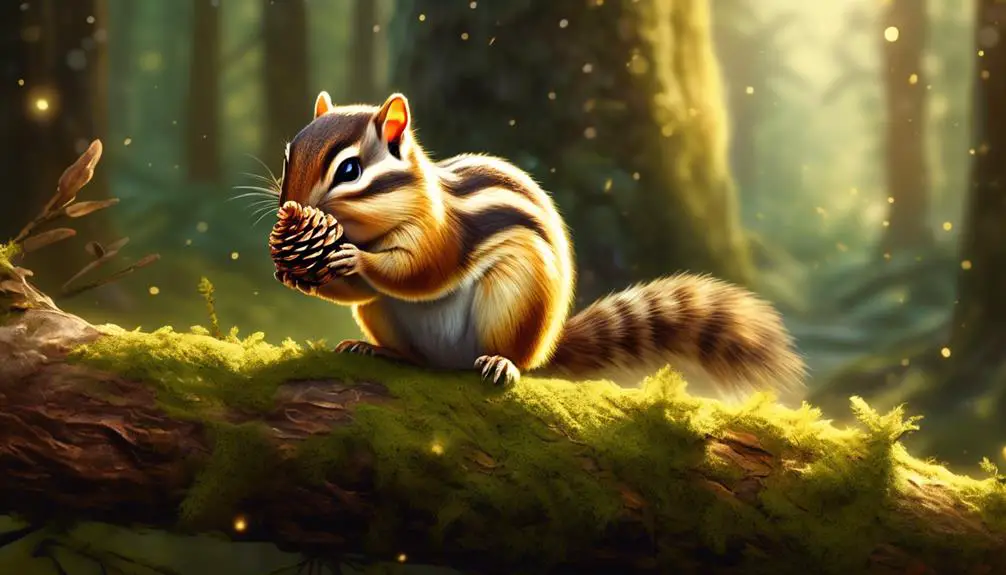
Chipmunks have a varied diet that includes pine cones, among other food sources. They’re well adapted to consume pine cones, thanks to their sharp teeth that can easily break open the tough outer scales.
Chipmunks not only eat the seeds inside the pine cones but also play a role in seed dispersal, as they may bury the seeds for later consumption or unintentionally drop them while moving around, contributing to the regeneration of pine forests.
Chipmunk Diet and Behavior
Chipmunks, small rodents known for their lively and energetic behavior, play a vital role in the ecosystem by consuming pine cones as part of their diet.
Chipmunks have a varied diet that includes seeds, nuts, fruits, and insects, but they also rely on pine cones as a source of food. With their sharp incisors, chipmunks are able to break open the tough scales of pine cones to access the nutritious seeds within.
They often collect and store these seeds in underground burrows or in their cheek pouches for later consumption. By consuming pine cones, chipmunks not only fulfill their nutritional needs, but they also contribute to the dispersal of pine seeds, aiding in the regeneration of pine forests.
Chipmunks’ behavior of consuming pine cones demonstrates their adaptability and resourcefulness in utilizing available food sources in their environment.
Chipmunk Adaptations for Pine Cone Consumption
To adapt to consuming pine cones, chipmunks have developed specific physical and behavioral characteristics.
Chipmunks have sharp incisors that allow them to break open the tough outer scales of pine cones. Their teeth are continuously growing, enabling them to gnaw through the cone and access the nutritious seeds inside.
Chipmunks also have cheek pouches that they use to store the seeds for later consumption or to carry them to their burrows. These pouches can expand to several times the size of their heads, allowing chipmunks to gather and transport a large amount of food efficiently.
Additionally, chipmunks have agile and dexterous forelimbs that enable them to manipulate the pine cone and extract the seeds with precision. Their quick movements and nimble fingers aid in their ability to handle and consume pine cones effectively.
Chipmunks as Seed Dispersers
Seed dispersal plays a crucial role in the life cycle of many plants. Chipmunks contribute to this process through their interaction with pine cones.
Chipmunks, small rodents known for their cheek pouches and bushy tails, play an important role in dispersing pine cone seeds. When chipmunks encounter pine cones, they use their sharp teeth to break open the cones and extract the seeds.
They then carry the seeds in their cheek pouches and scatter them in various locations as they forage for food or establish their territories. This behavior helps to disperse the seeds over a wider area, increasing the chances of successful germination and the establishment of new pine trees.
Chipmunks’ role as seed dispersers highlights the intricate relationship between animals and plants in maintaining the biodiversity of ecosystems.
Animals That Rely on Pine Cones for Nutrition
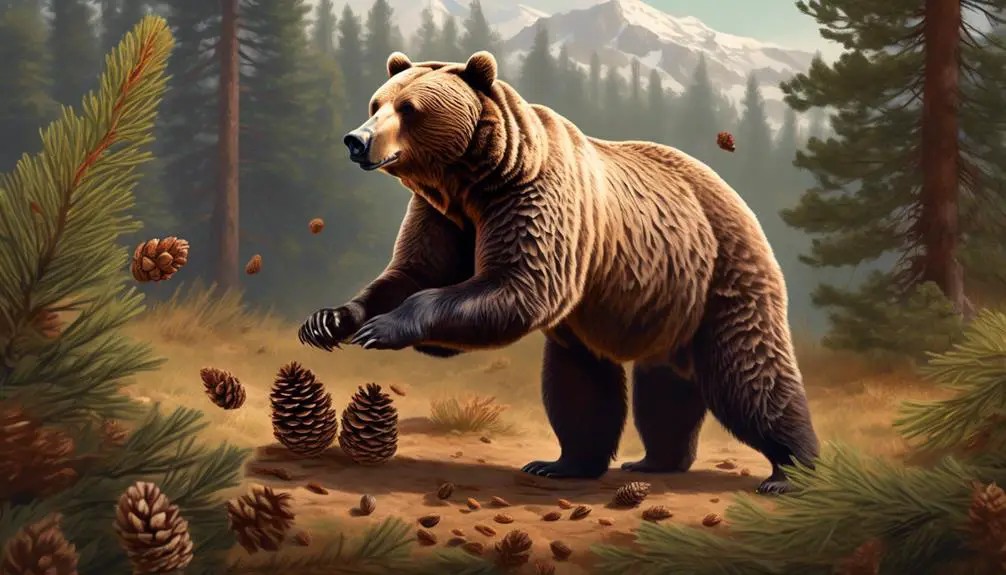
Animals such as squirrels, deer, woodpeckers, and raccoons rely on pine cones as a valuable source of nutrition. Pine cones provide these animals with essential nutrients, especially during periods when other food sources are scarce. Let’s take a closer look at how each of these animals benefits from consuming pine cones:
| Animal | Nutritional Benefits | Feeding Behavior |
|---|---|---|
| Squirrels | Pine cones and nuts in their hoards are a vital food source during winter. | They chew on brown pine cones to access the seeds and can break open dry and green pine cones with their sharp teeth. |
| Deer | Pine cones and pine needles provide nutrition when other food sources are limited. | They rely on pine cones, particularly whitetail deer, and feed on them during the winter season. |
| Woodpeckers | Pine cone seeds form a significant part of their diet. | They use their sharp beaks to strip open the pine cones and jam them into branches for a better grip before pecking into them. |
| Raccoons | Pine cones are edible due to their omnivorous nature. | They climb coniferous trees, using their sharp claws to break open the outer case of pine cones, and consume them as part of their varied diet. |
Animals That Can Break Open Pine Cones
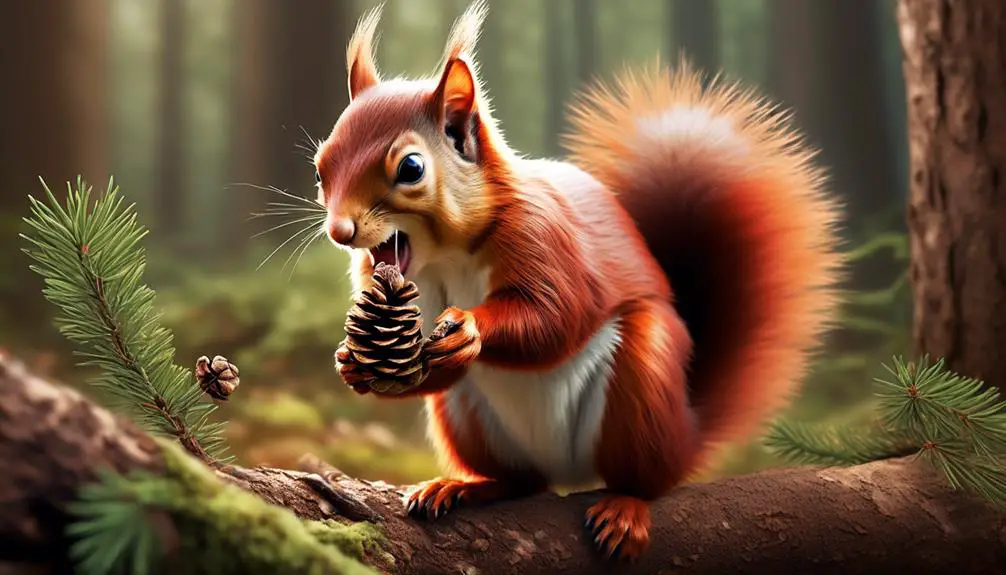
Various creatures possess the ability to skillfully break open pine cones in order to access the nutritious seeds inside. One such animal is the squirrel. Squirrels collect and store pine cones, utilizing their sharp teeth to chew on the scales and access the seeds. They can break open dry pine cones from bottom to top, as well as green pine cones. Squirrels also gather and hoard female pine cones for later consumption.
Another animal that can break open pine cones is the woodpecker. With their sharp beaks, woodpeckers can strip open pine cones and extract the seeds inside. They often jam the pine cones into branches to gain a better grip before pecking into them. Evidence of woodpecker activity can be seen with broken pine cones found at the foot of pine trees.
Raccoons, being scavengers, also possess the ability to break open pine cones. They climb coniferous trees and use their sharp claws to break open the outer case of the pine cones. Raccoons are known for their omnivorous nature and will eat almost anything, including pine cones.
Pine Cones as a Winter Food Source
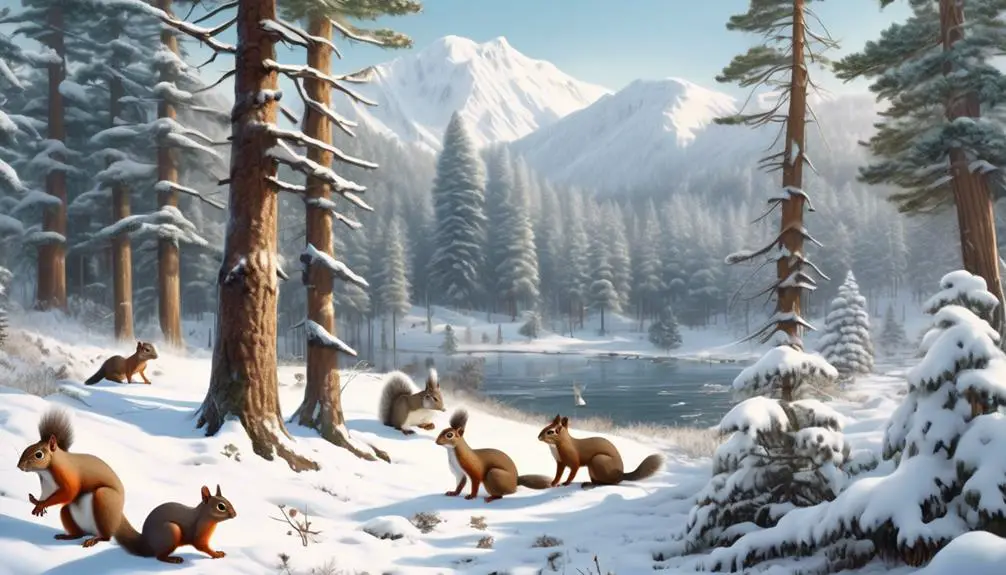
As we shift our focus to the winter season, it’s essential to explore the significance of pine cones as a valuable food source during this time. Pine cones serve as a crucial winter food source for many animals, providing them with the necessary nutrients to survive in harsh conditions. As other food sources become scarce, animals such as squirrels, deer, woodpeckers, and raccoons rely on pine cones for sustenance.
Squirrels are known to collect and store pine cones, chewing on the scales to access the nutritious seeds inside. They can break open both dry and green pine cones, utilizing their sharp teeth to extract the seeds.
Deer also turn to pine cones for nutrition during the winter months when suitable foliage is scarce. By consuming pine cones and pine needles, they can obtain the necessary sustenance to survive the cold season.
Woodpeckers, with their sharp beaks, are capable of breaking open pine cones to access the seeds inside. They often jam the cones into branches before pecking into them for a better grip.
Raccoons, being opportunistic scavengers, eat almost anything, including pine cones. They use their sharp claws to break open the outer case of the cones, making them accessible for consumption.
Pine Cones and the Omnivorous Diet
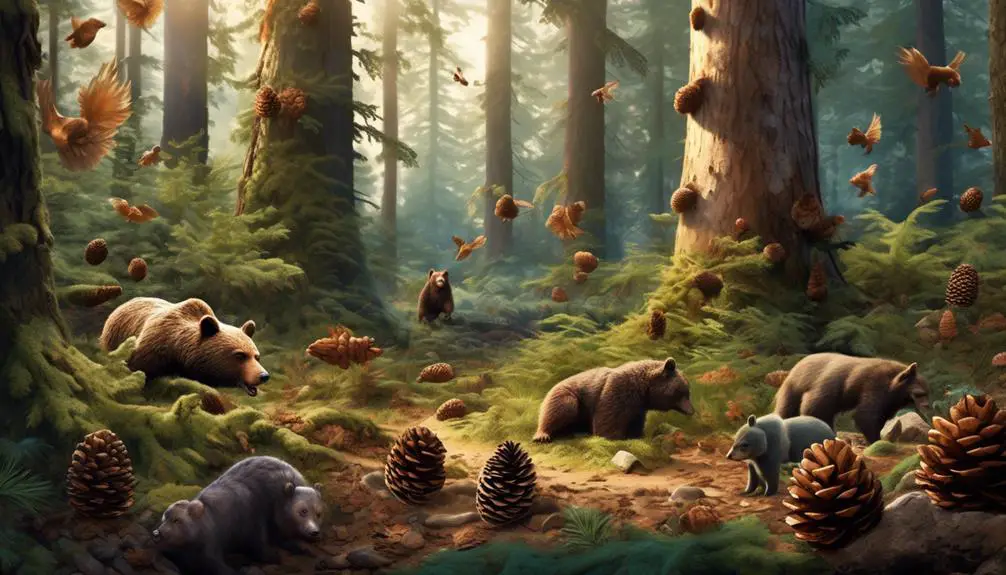
Pine cones play a significant role in the omnivorous diet of certain wildlife species. These animals have adapted to consume a variety of foods, including pine cones, to meet their nutritional needs.
| Animal | Diet | Adaptations |
|---|---|---|
| Raccoons | Omnivorous | Climb trees and use sharp claws to break open pine cones. |
| Squirrels | Omnivorous | Collect and store pine cones, chewing on the scales to access the seeds. |
| Chipmunks | Omnivorous | Have sharp teeth to break open pine cones and store the seeds for winter. |
Raccoons, being scavengers, have an omnivorous diet and can easily break open pine cones using their sharp claws. Squirrels also have an omnivorous diet and collect and store pine cones and nuts in their hoards. They chew on brown pine cones to access the seeds and can break open dry pine cones from bottom to top. Chipmunks, another omnivorous species, have sharp teeth that they use to break open pine cones and store the seeds for winter.
These animals have evolved specialized adaptations to consume pine cones as part of their diet. By including pine cones in their omnivorous diet, they are able to obtain essential nutrients and survive in their respective ecosystems.

Erzsebet Frey (Eli Frey) is an ecologist and online entrepreneur with a Master of Science in Ecology from the University of Belgrade. Originally from Serbia, she has lived in Sri Lanka since 2017. Eli has worked internationally in countries like Oman, Brazil, Germany, and Sri Lanka. In 2018, she expanded into SEO and blogging, completing courses from UC Davis and Edinburgh. Eli has founded multiple websites focused on biology, ecology, environmental science, sustainable and simple living, and outdoor activities. She enjoys creating nature and simple living videos on YouTube and participates in speleology, diving, and hiking.

